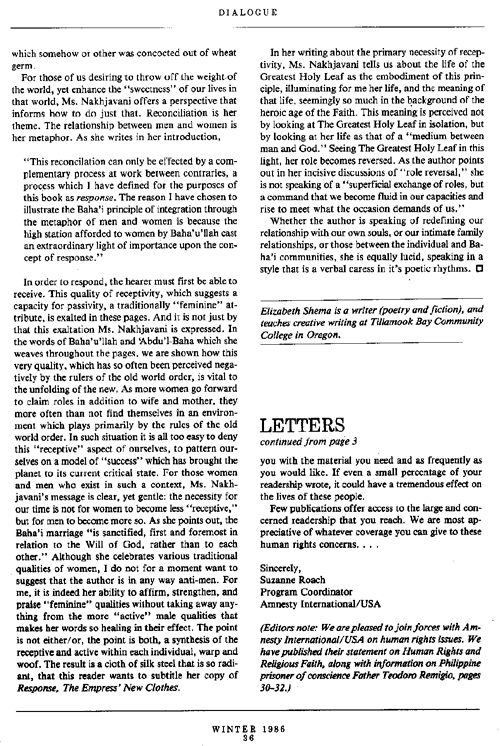
|
|
Notes: See also list of dialogue articles or image scans. |
Response, by Bahiyyih Nakhjavani:
Review
by Elizabeth Shema
published in dialogue, 1:1, pages 35-36Los Angeles: 1986
Author: Bahiyyih Nakhjavani
Published by: George Ronald, 1981, 144 pp.
Review by: Elizabeth Shema
Having just reread Response by Bahiyyih Nakhjavani, I feel as though I were a five year old with a very nasty cut on my psyche that has just been gently kissed by a loving aunt. This is a healing book, healing the wounds we inflict on ourselves, healing the wounds inflicted in contemporary woman-man relationships, and the wounds we suffer in our crashing about the contingent world. The medicine is offered by a woman who has managed to combine the quiet devotional tone one might expect of The Greatest Holy Leaf with the verbal pizzaz of Tahireh. She speaks of a quality of “calm intensity,” which she serves up in this exquisite dessert of words. If the book were a dessert, it would be a chocolate mousse, which somehow or other was concocted out of wheat germ.
For those of us desiring to throw off the weight of the world, yet enhance the “sweetness” of our lives in that world, Ms. Nakhjavani offers a perspective that informs how to do just that. Reconciliation is her theme. The relationship between men and women is her metaphor. As she writes in her introduction,
“This reconciliation can only be effected by a complementary process at work between contraries, a process which I have defined for the purposes of this book as response. The reason I have chosen to illustrate the Bahá'í principle of integration through the metaphor of men and women is because the high station afforded to women by Bahá'u'lláh casts an extraordinary light of importance upon the concept of response.”In order to respond, the hearer must first be able to receive. This quality of receptivity, which suggests a capacity for passivity, a traditionally “feminine” attribute, is exalted in these pages. And it is not just by that this exaltation Ms. Nakhjavani is expressed. In the words of Bahá'u'lláh and 'Abdu'l-Bahá which she weaves throughout the pages, we are shown how this very quality, which has so often been perceived negatively by the rulers of the old world order, is vital to the unfolding of the new. As more women go forward to claim roles in addition to wife and mother, they more often than not find themselves in an environment which plays primarily by the rules of the old world order. In such situation it is all too easy to deny this “receptive” aspect of ourselves, to pattern ourselves on a model of “success” which has brought the planet to its current critical state. For those women and men who exist in such a context, Ms. Nakhjavani’s message is clear, yet gentle: the necessity for our time is not for women to become less “receptive,” but for men to become more so. As she points out, the Bahá'í marriage “is sanctified, first and foremost in relation to the Will of God, rather than to each other.” Although she celebrates various traditional qualities of women, I do not for a moment want to suggest that the author is in any way anti-men. For me, it is indeed her ability to affirm, strengthen, and praise “feminine” qualities without taking away anything from the more “active” male qualities that makes her words so healing in their effect. The point is not either/or, the point is both, a synthesis of the receptive and active within each individual, warp and woof. The result is a cloth of silk steel that is so radiant, that this reader wants to subtitle her copy of Response, The Empress’ New Clothes.
In her writing about the primary necessity of receptivity, Ms. Nakhjavani tells us about the life of The Greatest Holy Leaf as the embodiment of this principle, illuminating for me her life, and the meaning of that life, seemingly so much in the background of the heroic age of the Faith. This meaning is perceived not by looking at The Greatest Holy Leaf in isolation, but by looking at her life as that of a “medium between man and God.” Seeing The Greatest Holy Leaf in this light, her role becomes reversed. As the author points out in her incisive discussions of “role reversal,” she is not speaking of a “superficial exchange of roles, but a command that we become fluid in our capacities and rise to meet what the occasion demands of us.”
Whether the author is speaking of redefining our relationship with our own souls, or our intimate family relationships, or those between the individual and Bahá'í communities, she is equally lucid, speaking in a style that is a verbal caress in its poetic rhythms.
Elizabeth Shema is a writer (poetry and fiction) and teaches creative writing at Tillamook Bay Community College in Oregon.
 click for larger image |
 click for larger image |
|
|